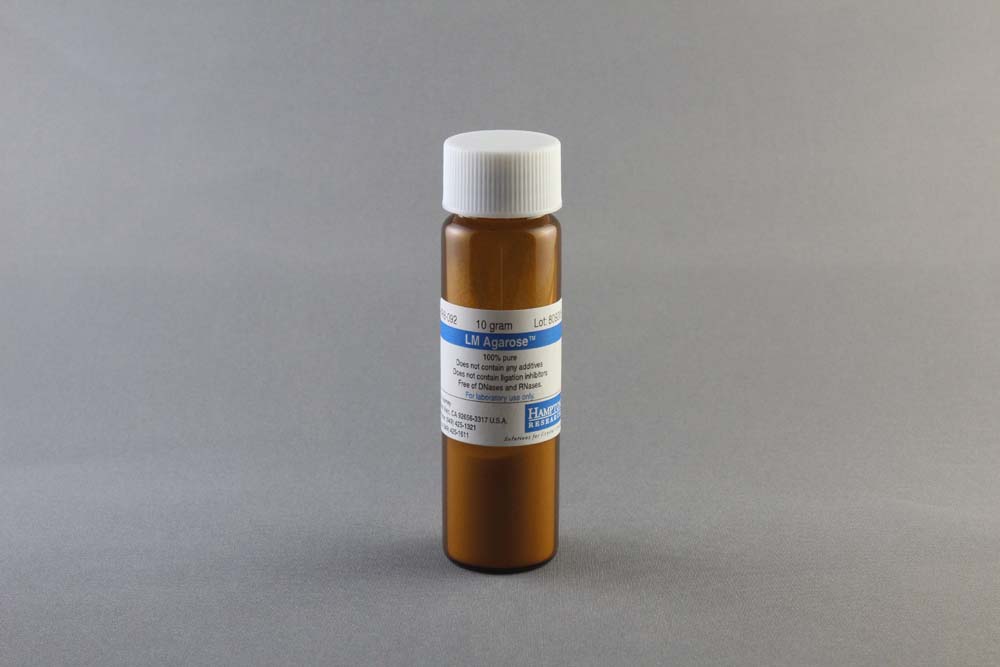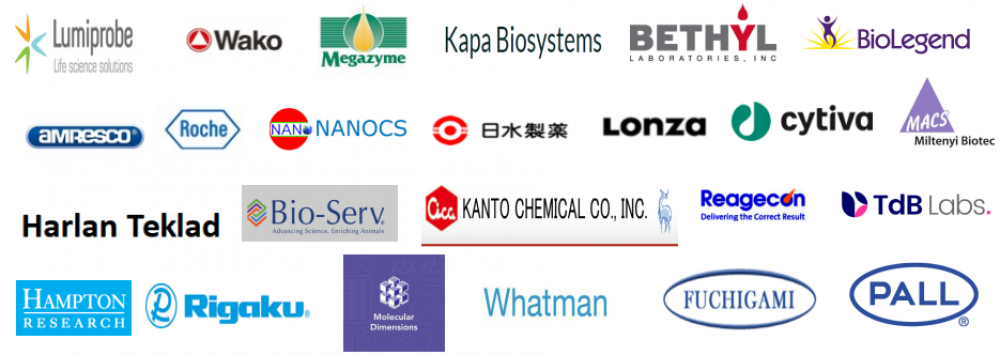Low Melting Agarose Gel-Hampton低熔点琼脂糖凝胶
上海金畔生物代理Hampton research品牌蛋白结晶试剂耗材工具等,我们将竭诚为您服务,欢迎访问Hampton research官网或者咨询我们获取更多相关Hampton research品牌产品信息。


Products > Optimization Screens > Low Melting Agarose > Low Melting Agarose Gel
Low Melting Agarose Gel
Applications
- Crystallization in agarose gel
Features
- Gel matrix can reduce nucleation and sedimentation
- Crystallization grade
- Low melting agarose
Description
Low melting (LM) agaroses are the result of a derivatization process by organic synthesis. Essentially, the process generates methoxylate groups from the basic agarose structure. The main properties of these agaroses are their low melting and gelling temperatures when compared with standard agaroses. LM agaroses have lower gel strength than standard agaroses, yet they can be handled easily. LM agaroses have higher clarity (gel transparency) than gels of standard agaroses. LM agaroses have great sieving capacity. The gelling temperature of LM agaroses is 24 to 28°C.
Agarose is a neutral polysaccharide extracted from the cellular walls of Rhodophyceae algae belonging to the genera Gelidium, Gelidiella, Pterocladia, Gracilaria, and Ahnfeltia, also known as agarophyte seaweed. The structure of the polysaccharide is that of a galactan, formed by linking agarobioses by links 1-3, 1-4. This chemical structure gives agaroses the capacity to form strong gels even at low temperatures. The gels have a macroreticular structure with a very open mesh which can be adjusted simply by varying the concentration of the agarose. The macroreticule structure of the agarose gel is formed by hydrogen bonds, which makes the gel reversible, transforming the gel into a solution by heating. The hysteresis (difference between gelling and melting temperature) is greater than any other hydrocolloid. The absence of ionic groups makes the gel a neutral structure. With no interaction, macromolecules can migrate through the gel mesh, making the gel an efficient sieve for biological macromolecules.
The LM Agarose offered by Hampton Research is 100% pure, does not contain any additives, does not contain ligation inhibitors, and is free of DNAses and RNAses. Hampton Research LM agarose is clearer than other agaroses and also has a higher gel strength.
应用
在琼脂糖凝胶中结晶
特征
凝胶基质可以减少成核和沉淀
结晶度
低熔点琼脂糖
描述
低熔点 (LM) 琼脂糖是有机合成衍生化过程的结果。本质上,该过程从基本的琼脂糖结构生成甲氧基化物基团。与标准琼脂糖相比,这些琼脂糖的主要特性是它们的低熔点和胶凝温度。 LM 琼脂糖的凝胶强度低于标准琼脂糖,但易于处理。 LM 琼脂糖比标准琼脂糖凝胶具有更高的透明度(凝胶透明度)。 LM 琼脂糖具有很强的筛分能力。 LM 琼脂糖的胶凝温度为 24 至 28°C。
琼脂糖是从属于石花菜属、石花菜属、紫菜属、江蓠属和 Ahnfeltia 属的红藻科藻类的细胞壁中提取的中性多糖,也称为琼脂藻海藻。多糖的结构是半乳聚糖的结构,通过连接 1-3、1-4 连接琼脂二糖而形成。这种化学结构使琼脂糖即使在低温下也能形成强凝胶。凝胶具有大网状结构和非常开放的网孔,可以通过改变琼脂糖的浓度简单地进行调整。琼脂糖凝胶的大网状结构是由氢键形成的,使凝胶可逆,通过加热将凝胶转化为溶液。滞后(胶凝温度和熔化温度之间的差异)比任何其他水胶体都大。离子基团的缺失使凝胶呈中性结构。在没有相互作用的情况下,大分子可以通过凝胶网迁移,使凝胶成为生物大分子的有效筛子。
Hampton Research 提供的 LM 琼脂糖是 100% 纯的,不含任何添加剂,不含连接抑制剂,不含 DNA 酶和 RNA 酶。 Hampton Research LM 琼脂糖比其他琼脂糖更透明,凝胶强度也更高。



CAT NO
HR8-092
NAME
DESCRIPTION
10 g bottle
PRICE
$71.00
cart quote
Support Material(s)
 HR8-092 LM Agarose User Guide
HR8-092 LM Agarose User GuideCertificate Of Analysis
Related Item(S)
- 3 Well Midi UVXPO
References
1. Robert, M. C. and Lefaucheux, F. Crystal growth in gels: principle and application. J. Cryst. Growth. 90:358-367, 1988.
2. Lorber et al, Journal of Crystal Growth 204 (1999) 357-368.
3. Lorber et al, Acta Crystallographic D55 (1999) 1491-1494.
4. Provost K., Robert, M.C., Application of gel growth to hanging drop technique. Journal of Crystal Growth 110 (1991) 258-264.
5. Robert, M.C., Vidal, O., Garcia-Ruiz, J.M., and Otalora, F., Crystallization in gels and related methods. Crystallization of Nucleic Acids and Proteins, (1999)149-175, Oxford University Press, ISBN 0-
6. J.M.Garcia-Ruiz, A. Hernandez-Hernandez, J. Lopez-Jaramillo, and B. Thomas. “Crystallization screening directly in electrophoresis gels”. Journal of Crystal Growth 232, 596-602, (2001).
7. J.A. Gavira, J.M. Garcia-Ruiz. Agarose as crystallisation media for proteins II: Trapping of gel fibres into the crystals. Acta Crystallographica D 58, 1653-1656, (2002).
8. Agarose gels and the Granada Crystallization Box (http://lec.ugr.es/)
9. Basel Box, A. D′Arcy et al (2003) (method employing pipet tips and cuvettes for Counter-Diffusion crystallization).
10. Chayen, N.E., “A Novel Technique to Control the Rate of Vapour Diffusion, Giving Larger Protein Crystals” J. Appl. Cryst. 30 (1997), 198-202.
11. Chayen, N.E., “The Role of Oil in Macromolecular Crystallisation” Structure 5 (1997), 1269-1274.
